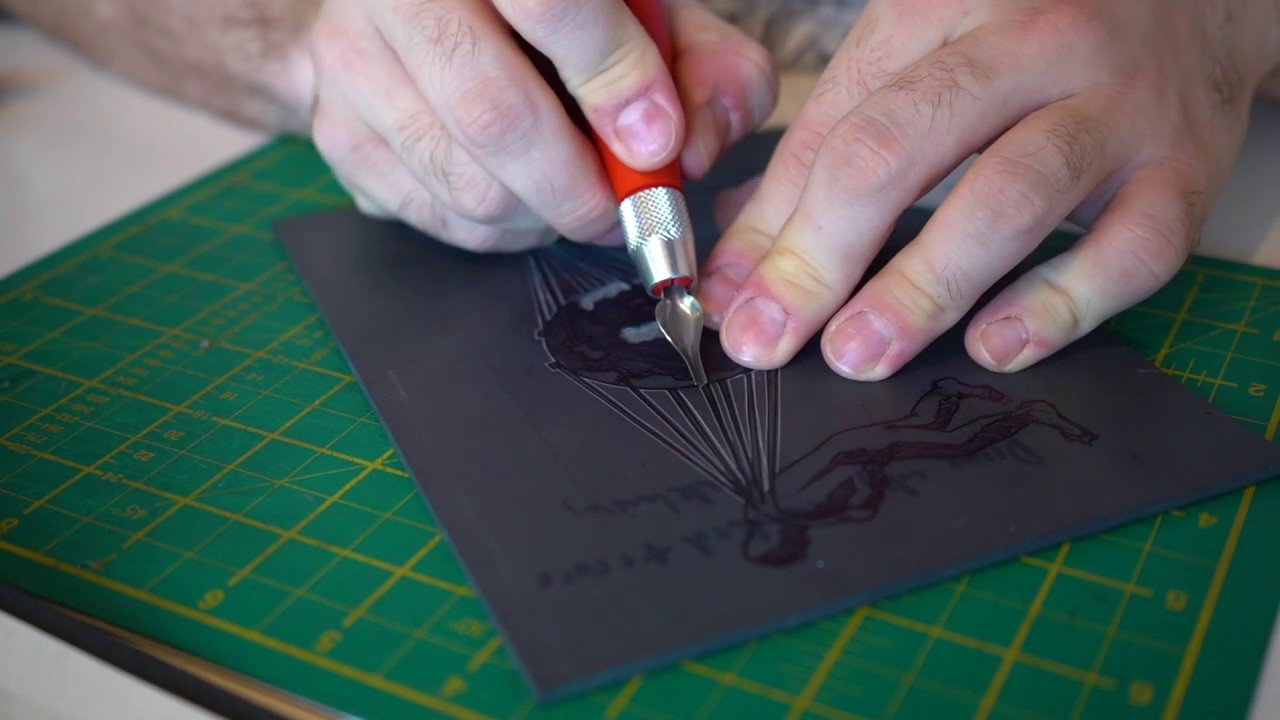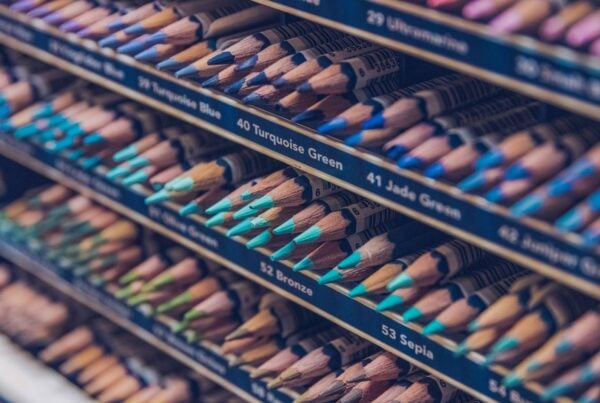Lino Cutter Buying Guide: Choose the Right Blade, Handle & Tool Sets
Choosing the right lino cutting tools is essential whether you’re a beginner or have some experience in printmaking. The correct tools enhance your control and precision, making it easier to bring your creative ideas to life. I’ll guide you through the basics of selecting linocut tools that suit your needs.
The world of linocut tools offers a wide range of options, from beginner sets to professional tools. Considering the material quality is crucial; durable tools will last longer and help achieve finer details. Look for tools that feel comfortable to hold, as they can reduce hand fatigue during longer carving sessions. Hickman Design has a selection of lino printing tools that can improve your carving precision and comfort.
By focusing on ergonomics and tool maintenance, you can maximise your investment and keep your tools in top shape. Whether you’re working with different types of lino or exploring various cutter shapes, the right tools will support your creative journey.
Key Takeaways
- Choosing the right tools enhances precision and comfort.
- Consider material quality and tool durability.
- Ergonomics and maintenance are key for long-term use.
Table of Contents
Understanding Linocut
Linocut is a unique form of relief printmaking that has evolved over the years. Combining historical roots with contemporary techniques, it presents an engaging way to produce artistic prints. Below, I explore its history and current significance in modern printmaking.
History of Linocut
Linocut emerged in the early 20th century as artists sought new materials for block printing. Unlike woodblock printing, linocut uses linoleum, a more accessible material that allows for greater flexibility and creativity. Its smooth texture makes carving easier, gaining popularity among both beginners and experts.
Pablo Picasso and Henri Matisse were among the first famous artists to use linocut, contributing to its recognition in the art world. The simplicity of the tools needed, along with the ability to produce multiple prints from a single carving, helped solidify its role in art history. This technique became a favourite for those exploring new expressions within the realm of printmaking.
Linocut in Modern Printmaking
Today, linocut remains a prominent technique in modern printmaking. It allows artists to create detailed and bold designs that are both unique and reproducible. Using modern tools and materials, artists continue to push the boundaries of what can be achieved with linocut.
The process involves sketching a design onto the lino block, carefully carving it out, and then applying ink before pressing paper onto it. This combination of classic and contemporary methods attracts many, including hobbyists and professionals, to explore its potential. Linocut’s appeal in a world of digital art lies in its tangible and hands-on nature, providing a creative outlet that resonates with many today.
Essential Tools for Beginners
Choosing the right lino cutting tools is key for beginners embarking on linocut art. It’s crucial to understand the different types of tools available and consider starter kits designed specifically for new users.
Types of Lino Cutting Tools
When starting out, it’s important to know the types of lino cutting tools available. Gouges and blades come in various shapes, including U-shaped and V-shaped. U-gouges are great for removing larger areas of lino, creating smooth curves and lines. V-gouges are better for intricate details and thinner lines. Having a variety allows me to experiment with different designs and techniques.
Investing in adjustable handles can make changing blades easier. Good quality tools are essential to ensure safety and precision. Avoid tools with flimsy handles or poorly constructed blades as they can lead to accidents or imprecise cuts. Selecting tools that feel comfortable in my hand makes the process more enjoyable.
Some sets include a variety of blades in one handle, offering good value. It’s possible to buy individual blades and gouges to build a personalised set. Visit lino cutting tools & carving sets to explore more options.
Starter Kits
Starter kits provide a comprehensive start for beginners. These kits typically include basic essentials such as a range of cutting blades, handles, and sometimes even printing ink and rollers. Choosing a kit reduces the complexity of buying separate items, ensuring I have everything needed to start carving right away.
These kits often come with easy-to-follow instructions, making them perfect for those new to the craft. Make sure the kit includes high-quality materials that will last as I practice and improve my skills. It’s beneficial to pick a kit that allows room for growth as I develop my technique.
Different brands offer varying combinations of tools, so it’s worth reading reviews to find the best fit for my needs. Some kits may offer additional resources such as instructional videos, which are handy for learning carving techniques efficiently.
Types of Linocut Tools
As an artist exploring linocut, understanding the types of tools available is crucial. Each tool serves a specific purpose and can greatly influence the outcome of your work. I’ll break down some of the most important tools, such as V and U gouges, those with interchangeable blades, and specialty carving tools.
V Gouge and U Gouge
When carving linoleum, V and U gouges are essential. A V gouge creates sharp, precise lines due to its narrow, angled shape. It’s ideal for detailing and adding fine texture to designs. Conversely, the U gouge is perfect for smooth, rounded cuts. Its curved blade scoops out larger areas, making it useful for shaping and creating bold lines. Both tools are versatile and commonly found in beginner tool sets.
Selecting the right gouge depends on the style of work you aim to achieve. Whether it’s creating intricate details with the V gouge or carving out larger spaces with the U gouge, these tools allow for creative expression. For those starting, many lino printing supplies offer sets that include both types. This helps artists experiment to see what works best for their projects.
Interchangeable Blades
Interchangeable blade tools offer flexibility for artists who want a range of cutting options without purchasing separate tools. These tools come with detachable blades in various shapes and sizes, allowing artists to switch between different types of cuts with ease. This versatility is especially helpful for artists working on diverse projects or those with limited storage space.
With interchangeable blades, one can quickly adapt their tool to suit the material’s hardness or the desired detail level. This option is budget-friendly since multiple blades fit a single handle, reducing the need to buy extra tools. Such sets are often recommended for beginners as they provide a broad introduction to linocut techniques.
Specialty Carving Tools
For those who want to take their art to the next level, specialty carving tools can offer unique results. These include knives and gouges designed for specific effects, like creating textured backgrounds or intricate patterns. Specialty tools are crafted to achieve shapes and designs that standard gouges might not be able to replicate.
Using these tools can elevate your linocut prints, allowing for more detailed and expressive artwork. They cater to artists looking to explore beyond the basic marks made by standard tools. Investing in a few specialty carving tools over time can significantly enhance your toolkit, leading to new artistic possibilities.
Material Quality and Durability
When choosing lino cutting tools, material quality and durability are crucial for achieving the best results. High-quality tools last longer and ensure clean and precise cuts.
Durability is essential. Frequent usage requires tools that can withstand wear and tear. Pfeil tools are known for their long-lasting performance. Made from specially alloyed steel, they are a favourite among printmakers because of their robustness.
I often find that the handle material plays a vital role in comfort and longevity. Wooden handles, like those in some Pfeil and Flexcut lino printing sets, provide a natural grip and reduce strain during extended use. These handles also add durability and a comfortable handling experience. Flexcut tools offer flexibility with replaceable blades, adding to their longevity.
Tools from brands like Speedball also maintain a good balance between quality and affordability. Speedball offers a range of lino cutters that cater to different skill levels, from beginners to professionals.
It’s beneficial to look for tools made from hardened steel. This material resists blunting and maintains sharpness over time, resulting in a smoother cutting experience with less effort. Hardened steel tools usually require less frequent sharpening.
To summarise (without using that phrase), investing in quality tools pays off by improving your overall lino carving experience and ensuring your tools remain reliable throughout your artistic journey.
Ergonomics and Comfort
When choosing lino cutting tools, I find that ergonomics and comfort are crucial. A well-designed handle reduces strain on my hand and wrist, allowing me to work for longer periods without discomfort. The feel of the tool in my hand must be right, ensuring that I have a firm and comfortable grip.
I’ve noticed that tools like the Pfeil linocut tools are often praised for their ergonomic designs. These tools have handles that fit naturally in my hand, reducing fatigue during long carving sessions. Similarly, Japanese wood carving tools are known for their excellent balance and comfort.
A comfortable tool can make a significant difference. When a tool fits well, I carve with more precision and control. Some tools come with soft grips or contoured handles, which can enhance comfort. It’s important for me to try different styles to see what feels right.
Here’s a simple checklist I use for evaluating tool ergonomics:
- Handle shape: Does it fit comfortably in my hand?
- Material: Is the grip soft or textured for better hold?
- Weight: Is the tool’s weight balanced for easy control?
Considering these factors helps me stay focused on my art, knowing that I have tools that support my comfort and efficiency.
Fine Detail and Precision
When working on linocuts, achieving fine detail and precision is vital. The right tools make this possible by allowing for accurate cuts and smooth finishes. Let’s explore how to choose the best tools for detailed work and how to keep them in top shape.
Choosing Tools for Detailed Work
Selecting the right tools for intricate linocut work is crucial. For fine lines, the V-shaped gouge is ideal. Its design lets me create sharp, clean lines with ease. These tools come in various sizes; a 0.5mm Very Fine Japanese V Gouge is perfect for tiny details.
Another option is the U-shaped gouge, beneficial for carving smooth curves. The subtle curve ensures that cuts are gentle and controlled, which is essential in detailed projects. For extreme precision, the dot tool can be very useful. It is specifically designed for creating small dots and is a great choice for adding texture.
I also consider handle comfort, as a good grip can significantly improve control and reduce fatigue during long sessions. Look for tools with ergonomically designed handles. Quality and material are important too, as better-quality tools tend to last longer and perform better.
Maintaining Sharp Blades
Keeping my linocut tools in prime condition is imperative. Sharp blades reduce tearing and ensure accurate cuts. Regular sharpening of the cutting edges can be done using sharpening stones or honing kits. It’s crucial to understand the technique; align the blade correctly while sharpening to maintain the tool’s original shape.
Blades made of high-quality steel remain sharp longer and are easier to sharpen. Yet, even the best blades need attention. Always clean them after use to prevent dulling. A quick wipe with a clean cloth removes any residue, maintaining their effectiveness.
Proper storage is also key. Store tools in a dry place, preferably in a protective case, to avoid rust and damage. This care ensures the longevity of my tools and reliable performance for future projects.
Tool Maintenance and Care
Maintaining your lino cutting tools is crucial for their longevity and performance. Proper care includes regular cleaning, safe storage practices, and effective sharpening techniques.
Cleaning and Storage
After each use, I make sure to clean my lino cutting tools to prevent residue build-up. I gently wipe the blades with a soft, dry cloth to remove any debris. For stubborn bits, a damp cloth works well. It’s essential to avoid soaking tools in water to protect the handles from damage.
I always store my tools in a dry, cool place. I prefer using a dedicated box or case with individual slots to keep each tool separate. This prevents accidental nicks or scratches on the cutting edges. Proper organisation not only protects the tools but also makes it easier to find what I need quickly.
Sharpening Techniques
Keeping my lino cutting tools sharp is vital for achieving clean cuts and extending their life. I typically use a sharpening stone for this task. Holding the tool at the correct angle, I gently glide the blade across the stone without applying too much pressure. Consistent back-and-forth motions help maintain a uniform edge.
When precision is necessary, such as with intricate designs, I might use fine sandpaper instead. I also check the blades periodically for any signs of dullness or wear. Regular sharpening not only improves cutting efficiency but also reduces the risk of accidents caused by slipping on tough linoleum.
Variety and Versatility in Linocut Tools
When choosing lino-cutting tools, variety and versatility are key. In my experience, having a diverse range of tools allows artists to create unique and intricate designs. Interchangeable blade sets stand out for their adaptability. These are great for anyone looking to experiment with different cutting styles without needing to buy numerous individual tools.
The Pfeil tool set is a favourite among artists due to its quality and precision. Each tool has a specific function, from making broad strokes to detailed cuts. I find these tools ideal when aiming for high-detail artwork.
For those starting out or wanting a more flexible approach, the Flexcut Linoleum Printmaking Carving Set offers an excellent option. This set provides various blades suited for both soft and hard lino blocks. It’s useful for anyone needing to switch techniques mid-project.
In terms of tool shapes, V-gouges and U-gouges are essential. V-gouges help in creating fine lines, while U-gouges are perfect for clearing larger areas. Choosing tools with ergonomic handles can make long carving sessions more comfortable and precise.
Maintaining sharp blades is critical for achieving clean cuts. Tools with easy-to-change blades can save time, ensuring that your work remains consistent and smooth. An ergonomic design also helps in reducing fatigue, allowing for longer carving sessions without discomfort.
Exploring different tool sets can greatly enhance one’s linocut experience, making it more enjoyable and efficient. Whether you are a beginner or a seasoned artist, having versatile tools can elevate the quality of your work.
Frequently Asked Questions
Selecting the right lino cutting tools is essential for achieving precision and comfort. Each type of tool has its unique features, suited for different skill levels and project needs.
What are the key features to look for in a professional linocut tool?
When choosing a professional tool, I look for durability and comfortable grip. High-quality steel blades are crucial for maintaining sharpness. A sturdy handle that fits well in my hand can greatly enhance control, reducing fatigue during long carving sessions.
Can you recommend the best brands for linocut tools available in the market?
There are several reputable brands known for their quality. Essdee and Pfeil are popular choices among beginners and professionals alike. These brands offer a range of tools that provide excellent sharpness and control. You can find reliable options from Hickman Design’s selection of linocut tools.
What are the differences between Japanese linocut tools and Western ones?
Japanese tools often have blades made from harder steel, allowing for very fine and precise cuts. Their handles are typically smaller and lighter, suited for detailed work. Western tools, on the other hand, have more robust handles and blades, better for removing large areas of lino.
How do I determine which type of cutting tool is best for my linocut project?
The choice depends on the details and style of your project. For intricate designs, I opt for fine blades that offer precision. For larger, simpler patterns, wider blades help in removing material quickly. Tool sets like the ones reviewed by Michelle Hughes can provide versatility for beginners.
What should beginners consider when purchasing their first set of linocut tools?
Beginners should consider sets that include a variety of blade shapes and sizes. This allows experimentation with different carving styles. Comfort and ease of use are also important; tools with ergonomic handles can reduce hand strain. Brands such as Essdee are known for producing beginner-friendly sets.
How do power grip tools compare to traditional linocut tools in terms of control and ease of use?
Power grip tools offer enhanced control due to their specially designed handles, fitting naturally in the hand. They provide extra leverage compared to traditional tools, making them easier to manoeuvre. This can be particularly beneficial for those new to linocutting, allowing better precision with less effort.








